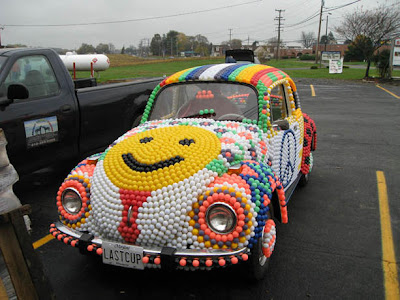
Santa Car Mark III. Actually the full name is Lincoln Santa Is Coming To Towne Car and was created by Brian Taylor who also created the Metro Santa Car and Machete Betties Roller Derby Art Car. I just came across this video

 |
| Russel Crow Truck |


 via
via








 Maybe art, maybe some art, maybe this art, maybe some of this art, serves turning the absence opaque, that is, making it at once palpable and impenetrable, so we cannot go back, so we are stuck in the appreciation of this strange, utopic now, and any attempt to overcome it, to look for the actual empty space, meets the opacity of an object, an image, a substitute, substitute not of a reality, but of what ceased to be, of the void that hence remains beyond us, happily or unhappily, hard to say, replaced by the fundamentally meager and helplessly sublime moment of a hesitant, aesthetic, experience, too private to be credible, too credible to be intimate, and yet ours, because we want it to be, because we claim it as such, because we know we inherited it from the silence that came before.
Maybe art, maybe some art, maybe this art, maybe some of this art, serves turning the absence opaque, that is, making it at once palpable and impenetrable, so we cannot go back, so we are stuck in the appreciation of this strange, utopic now, and any attempt to overcome it, to look for the actual empty space, meets the opacity of an object, an image, a substitute, substitute not of a reality, but of what ceased to be, of the void that hence remains beyond us, happily or unhappily, hard to say, replaced by the fundamentally meager and helplessly sublime moment of a hesitant, aesthetic, experience, too private to be credible, too credible to be intimate, and yet ours, because we want it to be, because we claim it as such, because we know we inherited it from the silence that came before. Lynda Farley is the creator of the Liberty van, and doing her part to creatively express her First Amendment Rights. Lynda believes in the rights of smokers to be able to smoke anywhere at anytime. She also believes that smoking dangers are a total myth perpetuated by "those" who are lying to us about the whole thing. She has taken pictures of her car in front every statehouse in the lower 48. She hopes to repeal smoking bans across the nation, restore our constitution, and get the word out on the smoking "hoax". Lynda is all "fired up" and has taken plenty of pictures of her journey, be sure to check out her Fall and Christmas tour pictures.
Lynda Farley is the creator of the Liberty van, and doing her part to creatively express her First Amendment Rights. Lynda believes in the rights of smokers to be able to smoke anywhere at anytime. She also believes that smoking dangers are a total myth perpetuated by "those" who are lying to us about the whole thing. She has taken pictures of her car in front every statehouse in the lower 48. She hopes to repeal smoking bans across the nation, restore our constitution, and get the word out on the smoking "hoax". Lynda is all "fired up" and has taken plenty of pictures of her journey, be sure to check out her Fall and Christmas tour pictures.


"In order to become a member of the Original Scraper Bike Team, you must: Be a resident of Oakland, CA. Be at least 7y/o or older. Retain A 3.0 Grade Point Average (GPA), Create your own Scraper Bike…(It Has To Be Amazing, Or Else You Can’t Ride.) A single-file line when riding. After 10 rides The Scraper Bike King and his Captains will decide if your bike is up to standards and if you can follow simple guidelines. After your evaluation we will consider you a member and honor you with an Original Scraper Bike Team Shirt. Only worn when Mobbin’ Stay posted to our website for all upcoming Scraper Bike Rides..." -- The Scraper Bike King





At an unknown date, but probably not much before the sixth century, the cult of Dionysus‑Bacchus, the 'raging' goat‑god of fertility and wine, spread from barbaric Thracia into Greece. The initial success of Bacchism was probably due to that general sense of frustration ... [that] the Olympian Pantheon had come to resemble an assembly of wax‑works, whose formalized worship could [not] satisfy truly religious needs.... A spiritual void tends to create emotional outbreaks; the Bacchae of Euripides, frenzied worshippers of the horned god....The Greeks discovered that their lofty aspirations were chained to their earthy goat-god origins. High culture could only take them so close to "perfection" before they ran out of chain.

The outbreak seems to have been sporadic and short‑lived. The Greeks, being Greeks, soon realized that these excesses led neither to mystic union with God, nor back to nature, but merely to mass-hysteria.... The authorities seemed to have acted with eminent reasonableness: they promoted Bacchus‑Dionysus to the official Pantheon with a rank equal to Apollo's. His frenzy was tamed, his wine watered down, his worship regulated, and used as a harmless safety‑valve.The Greeks' wise technique for co-opting wildness is still employed by artists today. A carefully controlled picture often includes an uncontrolled splatter or eruption or rough line-- not enough to lose control of the picture, but enough to show that wildness still has a seat in the artist's pantheon:








